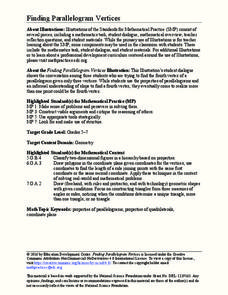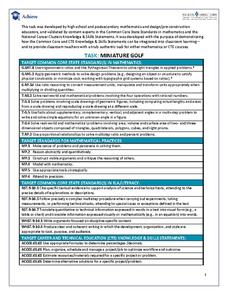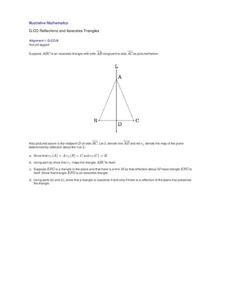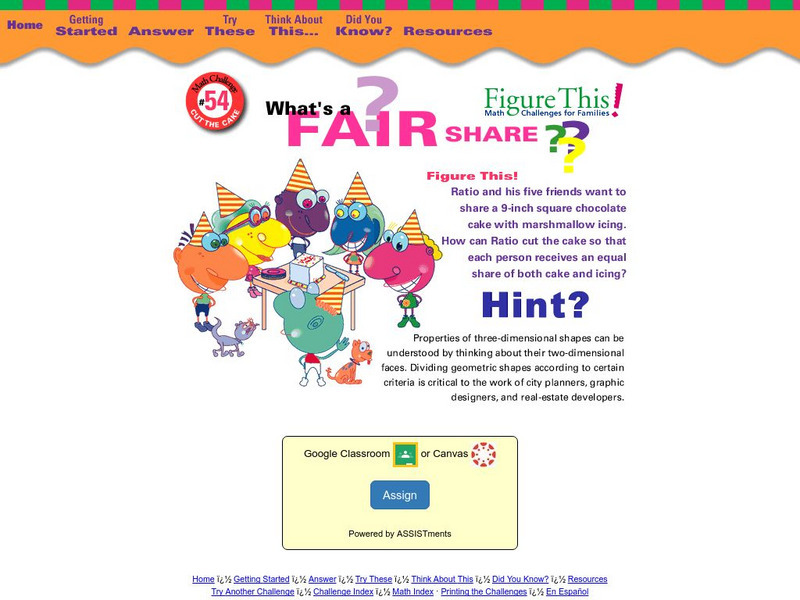Illustrative Mathematics
3-D Shape Sort
From the apple on your desk and the coffee cup in your hand, to the cabinets along the classroom wall, basic three-dimensional shapes are found everywhere in the world around us. Introduce young mathematicians to the these common figures...
Teach Engineering
Seeing All Sides: Orthographic Drawing
How can your draw three-dimensional figures on paper? The lesson shows pupils how to draw orthographic projections of three-dimensional figures composed of cubes. After viewing a PowerPoint presentation, they practice this skill with...
American Museum of Natural History
Thinking in the Three Dimensions
Discover different dimensions with paper folding. Pupils first read about zero, one, two, and three dimensions, and then learn about the fourth dimension, time. They then use origami to create models of shapes in three dimensions and use...
Curated OER
Partitioning a Hexagon
The task at hand is to partition a hexagon into two, four, and eight congruent figures. Make sure to give your wizards a sheet of triangle grid paper on which to decompose the hexagons. Have them explain which rotations, reflections, or...
Star Date
Shadow Play
Three activities make up a solar system lesson that features the sun, its light, and the shadows it produces. Scholars step outside to discover the changes shadows make at different times of day, take part in a demonstration of...
Teach Engineering
Connect the Dots: Isometric Drawing and Coded Plans
Individuals discover how to draw cubes on triangle-dot paper. They use cubes to build structures and draw corresponding isometric drawings on dot paper in the second lesson of the series of five. The activity also introduces the concept...
Agile Mind
Transforming Graphs of Quadratic Functions
In the activity on this webpage, learners use interactive graphing technology to investigate transformations of graphs. In the first part of the task, they look at the graph of a quadratic function with coordinates of a few points...
Education Development Center
Finding Parallelogram Vertices
Four is the perfect number—if you're talking about parallelograms. Scholars determine a possible fourth vertex of a parallelogram in the coordinate plane given the coordinates of three vertices. They read a conversation...
Curated OER
Task: Miniature Golf
"Fore!" All right, no one really yells this out in miniature golf, but this well-defined activity will have your charges using lots of numbers in their unique design of a miniature golf hole. Included in the activity criteria is the...
Texas State Energy Conservation Office
Investigation: Chemical Models
Science teams make models of four different hydrocarbon compounds that we commonly use for fuel. Then they demonstrate chemical reactions that result when energy is produced. This can be used as an enrichment when your class is studying...
Curated OER
Reflections and Equilateral Triangles
Your learners collaboratively find the lines of symmetry in an equilateral triangle using rigid transformations and symmetry. Through congruence proofs they show that they understand congruence in terms of rigid motions as they...
Education Development Center
Similar Triangles
Model geometric concepts through a hands-on approach. Learners apply similar triangle relationships to solve for an unknown side length. Before they find the solution, they describe the transformation to help identify corresponding sides.
Illustrative Mathematics
Reflections and Isosceles Triangles
Geometers explore symmetries of isosceles triangles by using rigid transformations of the plane. They complete four tasks, including congruence proofs, which illustrate the relationship between congruence and rigid transformations. The...
National Council of Teachers of Mathematics
Nctm: Figure This: Cut the Cake
A math challenge where geometry, measurement, and problem solving meet. Explore the properties of three dimensional shapes when you discover how six friends can equally divide a nine inch square chocolate cake. A one page activity from...
National Council of Teachers of Mathematics
Nctm: Figure This: Decorating Boxes
How do you print a ribbon on a box? The challenge is to figure out which of the patterns can be folded into a box with an orange ribbon printed all the way around it?
Other
Coloring 3 D Sides
Students use the colored portion of the 2-D drawings to color the correct face of the 3-D model. This applet consists of 20 problems. [Requires Java.]
Other
Coloring 2 D Sides
Learners use the colored portion of the 3-D object to color the correct side of the 2-D drawing. This applet consists of 20 problems. [Requires Java.]
National Council of Teachers of Mathematics
Nctm: Figure This: Visualizing
Is seeing believing? Explore visualizing and spatial reasoning with three dimensional shapes in this challenge from the NCTM Math Challenge for Families collection. Discover why visualization is essential skill in real world situations.
NumberNut
Number Nut: Shapes, Symbols, and Colors: 3 D Shapes
This lesson describes three dimensional shapes and provides two interactive practice activities.
Texas Instruments
Texas Instruments: Copying an Angle
Explore relationships (including congruence and similarity) among classes of two- and three-dimensional geometric objects, make and test conjectures about them, and solve problems involving them.
Other
Building Houses With Side Views
In this resource, 2-D views and 3-D figures are explored. Students build houses consisting of cubes using the given top, front, and right views. [Requires Java.]
NumberNut
Number Nut: Shapes, Symbols, and Colors: 2 D Shapes
Did you know that two-dimensional shapes are also called polygons? This lesson describes the various 2-D shapes and includes two interactive games to reinforce skills.
University of Cambridge
University of Cambridge: Nrich: Instant Insanity
Excellent interactive challenge working with cube nets to stack them in a specific order. Manipulate the cubes online to solve the problem.
Other
Freidenthal Instituut: Guess the View
Students are given a 3-D view of an object and then given a 2-D view of the object. Students must choose which of 6 views is being displayed from a list. This applet consists of 20 practice problems. [Requires Java.]























